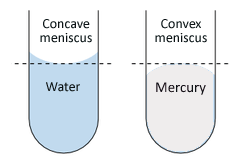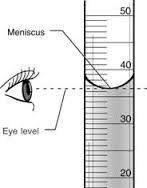What do call the curved surface of water in a measuring cylinder?
2 Answers
There are two opposing forces here: cohesion and adhesion .
Cohesion makes the molecules stick as close together as they can. This explains why water droplets tend to be spherical.
Adhesion makes molecules stick to other surfaces, e.g. glass. This is due to the attraction of the polar water molecules for the polar glass molecules (
With just water, there are no other surfaces to stick to, and cohesion wins (hence the round droplets of water, or water drops rolling off an impregated surface). If the polar water molecules can stick to a surface, adhesion wins and you will get a concave (hollow) surface.
Mercury does not adhere to glass, so mercury in a cylinder will curve the other way - convex.
In a graduated cylinder you would read the water level from the bottom of the curvature, and the mercury level from the top. You will think you misread, but it would be a tiny amount (=the raised 'rim' of the water), but this will be small, unless the cylinder is very narrow. Besides, the makers of these cylinders have taken this into account while graduating it.

The actual curve is called a meniscus. In water's case, you have a concave meniscus.
For aqueous solution you speak of the
Explanation:
For volumetric glassware, we line up the graduation with the lowest point on the meniscus.




